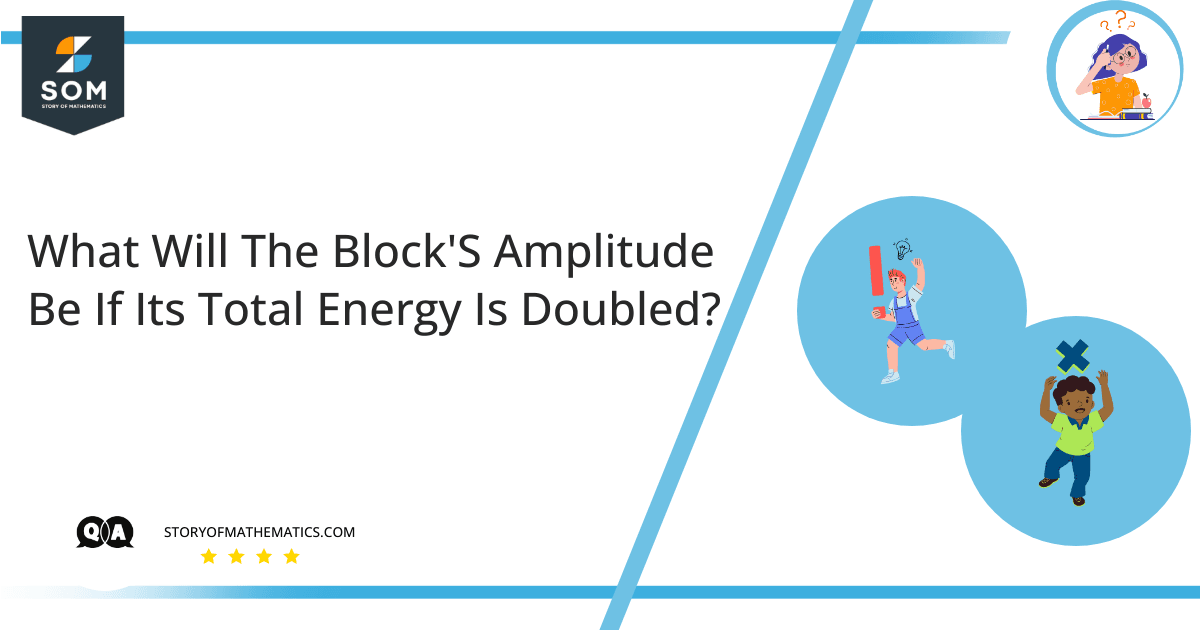
The main objective of this question is to find the amplitude of the oscillating block when the total energy gets doubled.This question uses the concept of simple harmonic motion and the total mechanical energy of simple harmonic motion. The total mechanical energy of the simple harmonic motion is equal to the sum of total kinetic energy and the sum of total potential energy.
Expert Answer
We are given with:
The amplitude of oscillating block $= 20 \space cm$.
We have to find the amplitude of the oscillating block when the total energy gets doubled.
We know that:
\[E \space = \space K \space + \space U\]
\[\frac{1}{2}kA^2 \space = \space \frac{1}{2}mv^2 \space + \space \frac{1}{2}kx^2\]
Mathematically, the total mechanical energy is represented as:
\[E \space = \space \frac{1}{2}kA^2\]
\[E \space = \space \sqrt \frac{2E}{k} \]
Then:
\[A \space = \space \sqrt E\]
\[\frac{A_1}{A_2} \space = \space \frac{\sqrt E}{\sqrt 2E} \]
\[\frac{A_1}{A_2} \space = \space \frac{1}{\sqrt 2} \]
\[A_2 \space = \space \sqrt2 (20)\]
\[A_2 \space = \space 28.28 \space cm\]
Numerical Answer
The amplitude of the oscillating block will be $28.28 \space cm$ when the total energy gets doubled.
Example
Oscillating blocks have an amplitude of $40 \space cm$, $60 \space cm$, and $80 \space cm$. Find the amplitude of the oscillating block when the total energy gets doubled.
We are given:
The amplitude of oscillating block $= 40 \space cm$.
We have to find the amplitude of the oscillating block when the total energy gets doubled.
We know that:
\[E \space = \space K \space + \space U\]
\[\frac{1}{2}kA^2 \space = \space \frac{1}{2}mv^2 \space + \space \frac{1}{2}kx^2\]
Mathematically, the total mechanical energy is represented as:
\[E \space = \space \frac{1}{2}kA^2\]
\[E \space = \space \sqrt \frac{2E}{k} \]
Then:
\[A \space = \space \sqrt E\]
\[\frac{A_1}{A_2} \space = \space \frac{\sqrt E}{\sqrt 2E} \]
\[\frac{A_1}{A_2} \space = \space \frac{1}{\sqrt 2} \]
\[A_2 \space = \space \sqrt2 (40)\]
\[A_2 \space = \space 56.56 \space cm\]
Now solving for $60 \space cm$ amplitude.
We are given:
The amplitude of oscillating block $= 60 \space cm$.
We have to find the amplitude of the oscillating block when the total energy gets doubled.
We know that:
\[E \space = \space K \space + \space U\]
\[\frac{1}{2}kA^2 \space = \space \frac{1}{2}mv^2 \space + \space \frac{1}{2}kx^2\]
Mathematically, the total mechanical energy is represented as:
\[E \space = \space \frac{1}{2}kA^2\]
\[E \space = \space \sqrt \frac{2E}{k} \]
Then:
\[A \space = \space \sqrt E\]
\[\frac{A_1}{A_2} \space = \space \frac{\sqrt E}{\sqrt 2E} \]
\[\frac{A_1}{A_2} \space = \space \frac{1}{\sqrt 2} \]
\[A_2 \space = \space \sqrt2 (60)\]
\[A_2 \space = \space 84.85 \space cm\]
Now solving for $80 \space cm$ amplitude.
We are given:
The amplitude of oscillating block $= 80 \space cm$.
\[E \space = \space K \space + \space U\]
\[\frac{1}{2}kA^2 \space = \space \frac{1}{2}mv^2 \space + \space \frac{1}{2}kx^2\]
\[E \space = \space \frac{1}{2}kA^2\]
\[E \space = \space \sqrt \frac{2E}{k} \]
\[A \space = \space \sqrt E\]
\[\frac{A_1}{A_2} \space = \space \frac{\sqrt E}{\sqrt 2E} \]
\[\frac{A_1}{A_2} \space = \space \frac{1}{\sqrt 2} \]
\[A_2 \space = \space \sqrt2 (80)\]
\[A_2 \space = \space 113.137 \space cm\]
